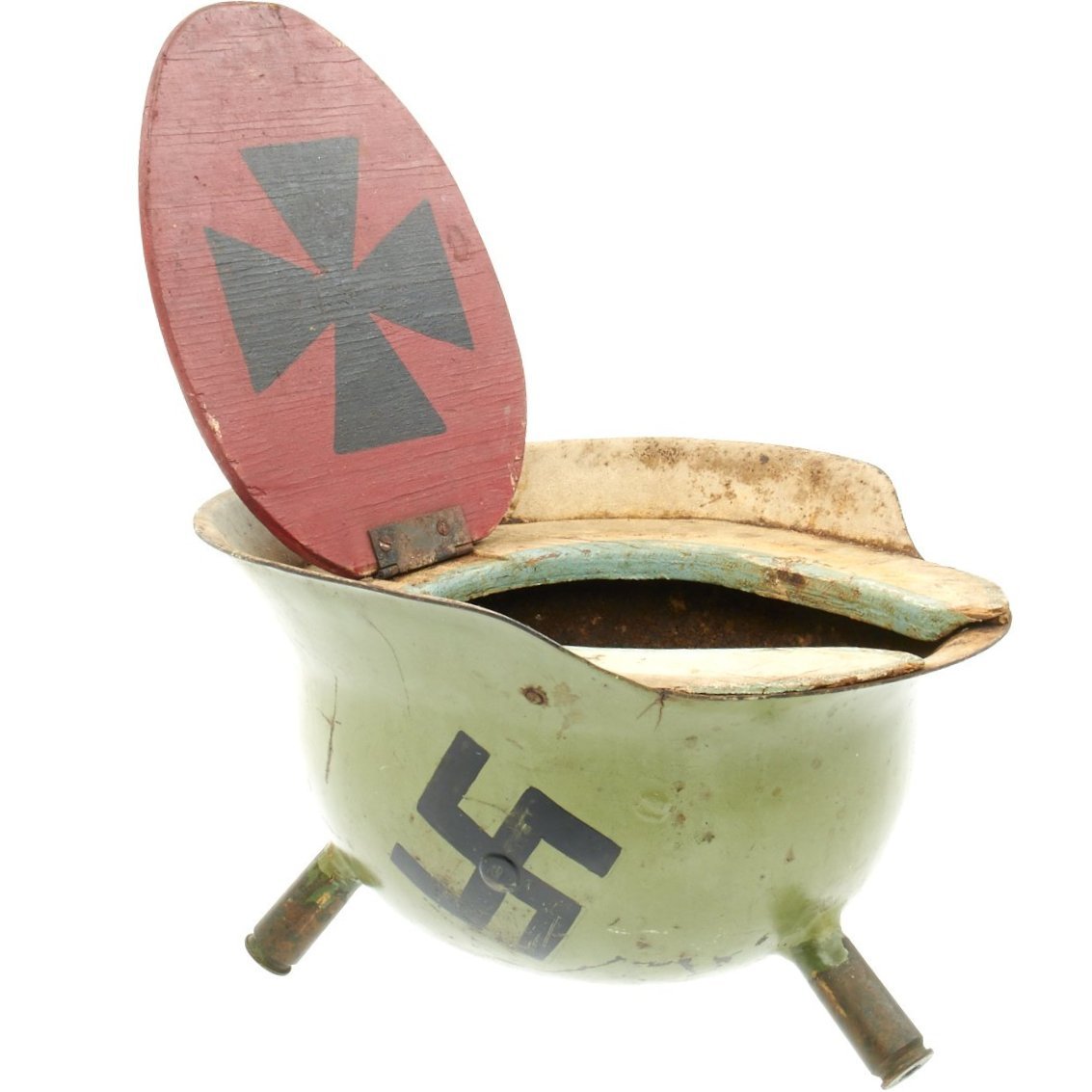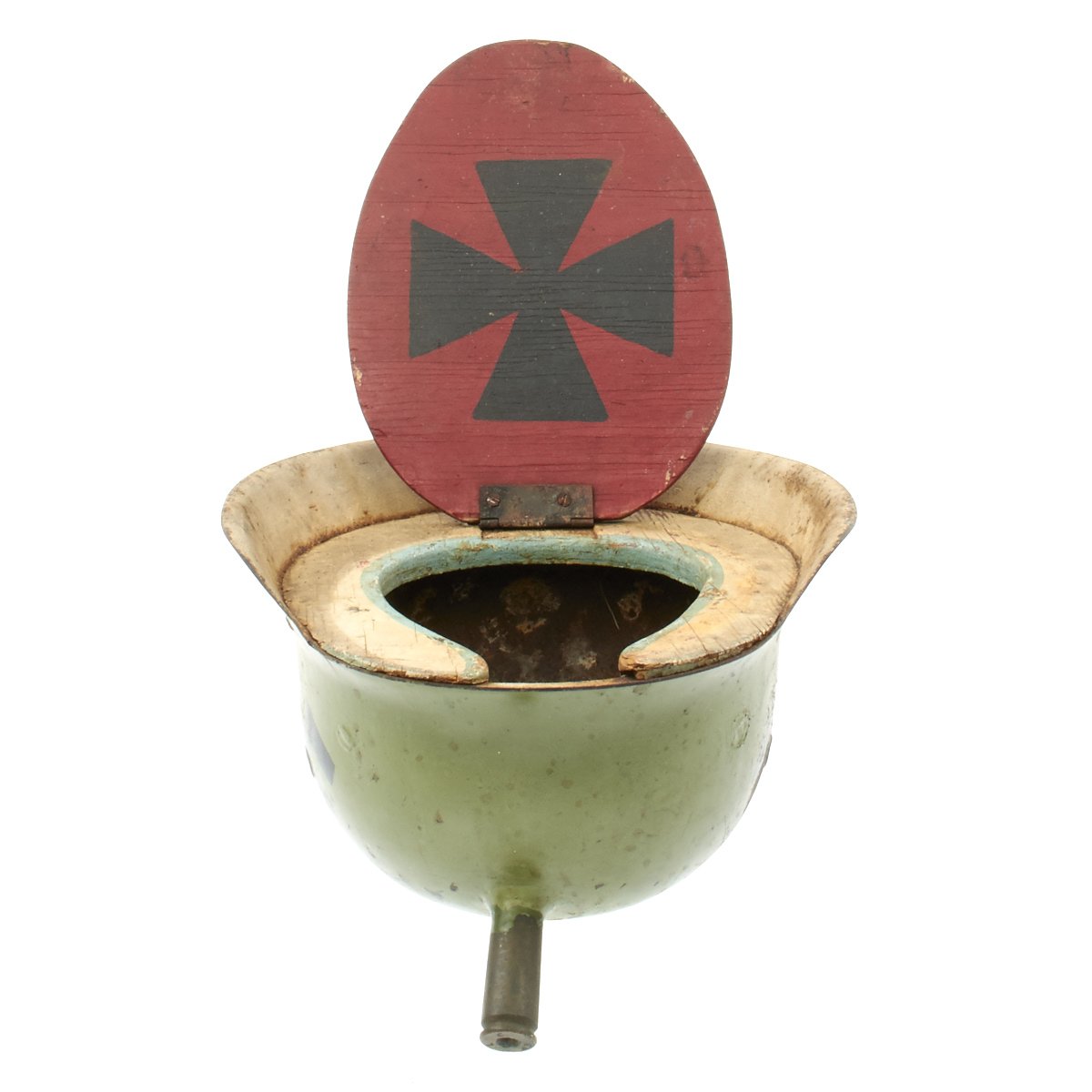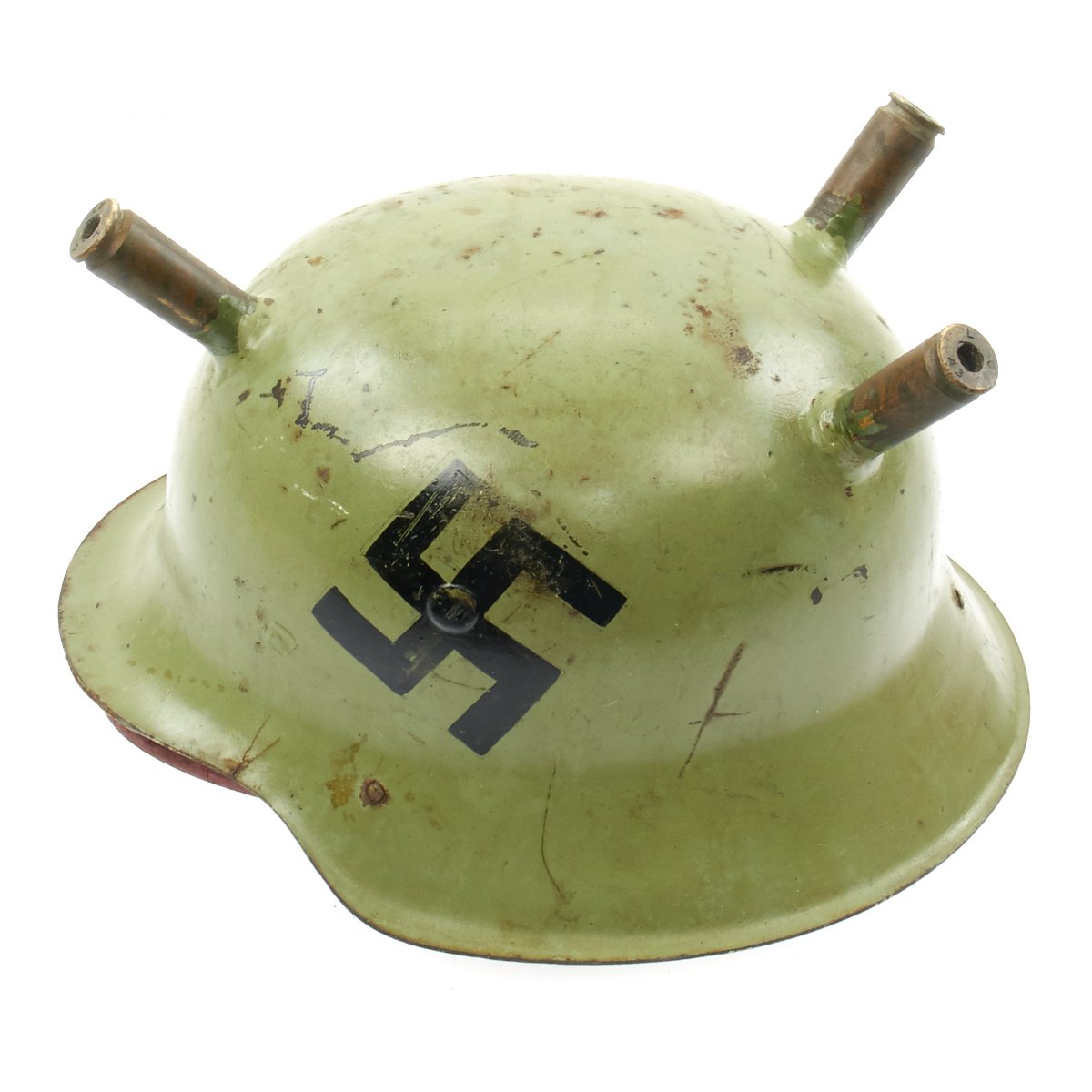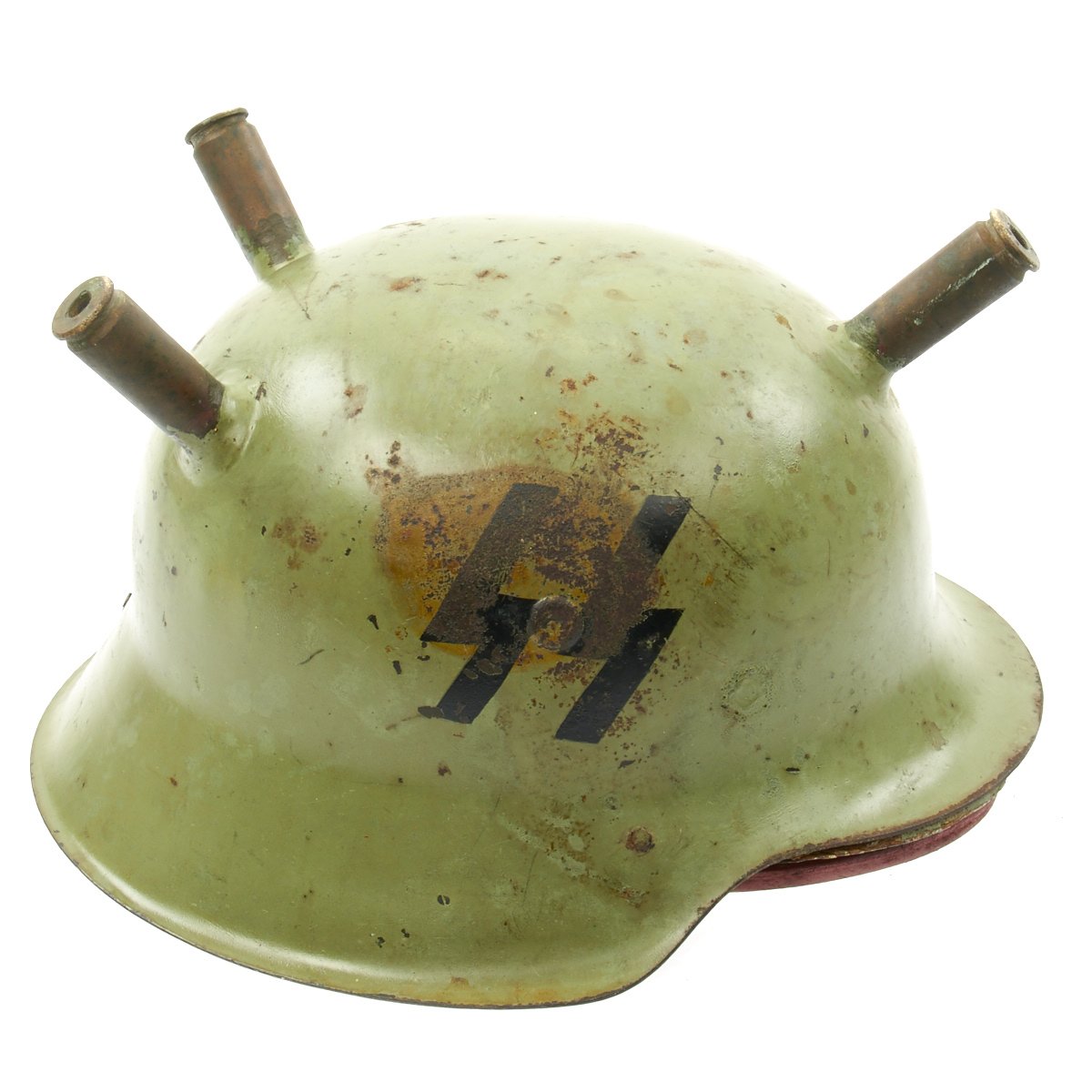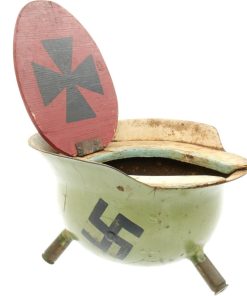Original German WWII M42 Helmet U.S. Trench Art Toilet – 324th Harbor Craft Company Original Items
$ 995,00 $ 248,75
Original Item: One-of-a-kind. This is hilarious; a genuine German WWII M42 helmet, probably a size 68 shell, which was nicely converted to a toilet by members of the U.S Army 324th Harbor Craft Company who were based in Antwerp, Belgium at the end of the war. Its ingeniously designed and built using three .50 caliber brass shell casings (all 1943 dated) as legs, a wooden toilet seat and a wood toilet seat cover. The cover is wonderfully painted red and bears the insignia for the 324th Harbor Craft Company on top. When you lift the cover a German Iron Cross is revealed. They also repainted the exterior of the shell a grey/green and filled in the liner holes. They even added a swas and SS symbol. You can’t make this stuff up! Perfect for the Army sailor with some time to kill and a full bladder. Makes a truly fantastic display piece and one heck of a conversation starter.
WWII US Army Harbor Craft Companies in Europe
During WWII U.S. Army Transportation Corps units served in port supply operations. The Army was were never very comfortable coordinating with the Navy, and it didn’t want to rely completely on civilian boat workers. For the Normandy invasion the US Army created the harbor craft companies to man its small supply craft, mostly barges, cranes, and tug boats. The War Department Field Manual FM 55-130: Transportation Corps Small Boats and Harbor Craft, published in 1944 gives a short description of the Army harbor craft company:
“The harbor craft company is a military unit organized for the purpose of ferrying cargo from freighters and transports arriving in theaters of operation. The vessels may either be riding at anchor offshore in the open sea or, which is more likely, anchored in a harbor. Cargo from ships is loaded by Transportation Corps port company personnel onto the barges. Tugs, tow boats, or marine tractors then propel these barges to the shore for unloading. Any cargo too heavy for the vessel’s gear lift is handled by the 60-ton floating crane.”
IN FRANCE
Harbor craft companies took part in the Normandy supply operations. Destination — Berlin! The Transportation Corps will furnish the necessary transportation! was small booklet published by The Stars and Stripes. It mentions the contribution made by the invasion’s harbor craft companies. It begins by marking the accomplishments of the 334th Harbor Craft Company:
“During August 1944 alone they performed 1403 channel operations. These army sailors towed 150 vessels and 288 barges into harbors, made 117 ferry trips, and threw in five salvage expeditions for good measure.”
As with the port battalions, these rear area troops often came under enemy fire. The same Stars and Stripes booklet describes an incident in the supply of Cherbourg:
“The men of the harbor craft companies had a big hand in making Cherbourg a success. Harbor craft companies are an invention of this war and this theater. The first six companies were activated at the Charleston POE in May 1943. During the last war the Army depended on French civilian tugboats, but this time the enemy made that impossible. The Army had foreseen this situation and was prepared.
This is typical of what these companies were up against at Cherbourg: the crew of one ST-75 in a July 18 convoy from Southampton to Cherbourg was made up of men from the 328th and 335th Harbor Craft Cos. In a dense fog this ST-75 and five other boats became separated from the convoy about midnight. Fired on when be approached the shore on the following morning, the ST-75’s ship’s master set a course to the north. Before he could clear the Channel Isles, enemy shore batteries opened fire.
The first round took off the foremast. Seven of the crew went overboard. One soldier-sailor refused to abandon ship and went down. A sergeant was so badly injured that he later died. An officer was severely wounded in the leg. The survivors clung to a rubber raft until nearly dark the next day, when they were picked up by a British destroyer and returned to England.”
IN BEGLIUM
In September of 1944 the immense port of Antwerp was captured by the Allies and it opened to shipping in November. Joining my grandfather’s port battalion there were the 334th, 339th, 344th, 345th, and 352nd harbor craft companies. The port had been closed during the German occupation, and the Allies allowed very few civilian ships after its liberation. Consequently, there was a huge population of unemployed Belgian port workers available. The Allies hired the civilians to unload and transport the flood of military supplies. Soldiers from the harbor craft companies and port battalions were then free to perform other military duties in the port. Many men from the harbor craft companies served guard duty on the supply ships, docks, and in the warehouses. They protected Allied supplies from black market heists while under a constant barrage of German V-bombs.
Fast Shipping with Professional Packaging
Thanks to our longstanding association with UPS FedEx DHL, and other major international carriers, we are able to provide a range of shipping options. Our warehouse staff is expertly trained and will wrap your products according to our exact and precise specifications. Prior to shipping, your goods will be thoroughly examined and securely secured. We ship to thousands clients each day across multiple countries. This shows how we're dedicated to be the largest retailer on the internet. Warehouses and distribution centres can be located throughout Europe as well as the USA.
Note: Orders with more than one item will be assigned a processing date depending on the item.
Before shipping before shipping, we'll conduct a thorough inspection of the items you have ordered. Today, the majority of orders will be delivered within 48 hours. The delivery time will be between 3-7 days.
Returns
The stock is dynamic and we cannot completely manage it because multiple stakeholders are involved, including our factory and warehouse. So the actual stock may alter at any time. It's possible that you may not receive your order once the order has been made.
Our policy is valid for a period of 30 days. If you don't receive the product within 30 days, we are not able to issue a refund or an exchange.
You can only return an item if it is unused and in the same state as the day you received it. You must have the item in its original packaging.
Related products
Uncategorized
Uncategorized
Armored Burgonet Helmet & Polearm from Scottish Castle Leith Hall Circa 1700 Original Items
Uncategorized
Uncategorized
Uncategorized
Uncategorized
Uncategorized
Uncategorized
Uncategorized
Uncategorized
Uncategorized
Uncategorized
Armoured Fighting Vehicles of the World: AFVs of World War One (Hardcover Book) New Made Items
Uncategorized
Uncategorized
Uncategorized
Uncategorized
Angolan Rebel 1970s era 60mm Inert Display Mortar from Angolan Civil War Original Items
Uncategorized
